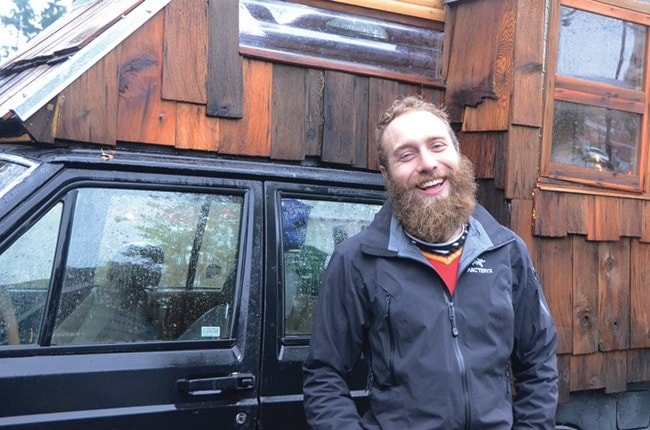Victoria-based artist Aubrey Burke is in town for one year on a Canada Council for the Arts grant.
He wants to share our stories with us, and he needs us to help him figure out how to do that.
But let's back up a bit.
The Campbell River Arts Council, not that long ago, was running a downtown space called The Incubator – or "The Cube" for short.
The Cube was an empty storefront – one of many empty storefronts in the downtown core those days, according to Ken Blackburn, executive director of the Arts Council.
"Back then," Blackburn says, "that whole area was a disaster. You wouldn't know it now, because Seymour Pacific has gone in there, and the city has done a revitalization and beautification project, but it used to be the slums down in there."
It was around the time the mill was "starting to get shaky on its feet," Blackburn says, "and everybody was talking about what Campbell River could do. The Arts Council was saying, without having a long-range plan, the least you've gotta do is take care of downtown. If you're going to attract new business and new industry, you can't have a downtown full of decrepit buildings with 'For Rent' signs all over the place that have obviously been there for years.
"This was a time to spruce things up."
Their idea was to let artists use some of those spaces.
"Let them run galleries, do projects, window pop-up things, whatever. Get some productive activity going on down there. That's not a new idea."
There have been many success stories, Blackburn says, where artists have moved into areas that were – let's call them less than desirable markets – and "gussied up the place, got some vibrancy going, created some commerce and activity, and then before you know it, people start to say, 'Oh, this place is pretty cool,' and the area explodes with investment and interest.
And they pitched this idea to city council.
And council bit on it – sort of.
At least it got the discussion started, which was enough to get Dan Samson – a local realtor who had empty space available – to let them move in and get some artsy things happening.
"We tried to use the space as an example of how the arts can be beneficial on a social level," Blackburn says. "Three artists worked in there, we ran a program through Family Services where marginalized youth came in and made art, and we did our head injury program in there, as well."
They also used the space for public forums about downtown beautification and arts in general as well as allowing many artists to put on exhibitions and shows when they needed a space to do so.
"It was great, because it was low cost, but high impact."
Then Seymour Pacific needed a production and construction office when their new building was being built, and the Arts Council got the boot. Which was fine, Blackburn says, because Seymour Pacific's building was what the Arts Council had been preaching the whole time – beautifying downtown.
Burke's project is a perfect opportunity to re-examine this concept, however, because he has come to town to look at how our community works and hold a mirror up for us. He wants to help us tell our stories to ourselves to help us look at who we are, where we are, what we mean, and be part of creating a cultural, collective, collaborative artistic endeavour that we can all identify with – because we'll be part of creating it.
The project is an extension and expansion of Burke's last endeavour, called the Story Booth Project, where he invited members of the public to come to a studio and record their stories and oral histories. Burke then worked with other artists to visualize those stories and screened the resulting art in the windows of the gallery while the recordings were played through outside speakers.
There's no way to tell at this point how the finished work of this particular project will look, as Burke has decided to let the stories themselves dictate the medium in which they are most suited to be told.
He doesn't want to depict people's realities for them this time. He wants it to be a collaboration.
The one thing he's sure of is that it will be installed so as to be a part of the city itself, not cooped up in a gallery.
"I'm interested in the structure of the art that I'm making changing the city's landscape, rather than have it be seen in a purely gallery-based context," Burke says. "I'm always coming back to, 'What does it mean to interlay art into a city, into open air, into places you wouldn't expect it? How can you surprise people and totally change the vibe of a city through the introduction of art?'"
He's looking at the project being finished and installed next summer, but before he can make this art which will be interlaid into the cityscape here, he needs to gather stories to tell.
He'll be going around talking to people, so don't be weirded out if you're approached over the next few months by a fella with a big bushy beard asking you to tell him a story. Alternatively, people with a story to tell – whether personal, historical, inspiring or depressing – or who know someone who is full of stories and loves to share them, can contact Burke directly at aubreyburke@gmail.com or give Blackburn a call down at the Arts Council at 250-923-0213 or by email at arts.council@crarts.ca and he'll put you in touch.
